Financial Analysis Report: Macmillan Cancer Support Performance
VerifiedAdded on 2023/01/05
|11
|3047
|86
Report
AI Summary
This report provides a financial analysis of Macmillan Cancer Support, examining its performance through ratio analysis over three years (2017-2019). The analysis includes calculations and interpretations of key financial ratios such as Return on Capital Employed (ROCE), Net Profit Margin, Current Ratio, Debtors Collection Period, Creditors Payment Period, and Efficiency Ratio. The report also discusses macro and microeconomic factors influencing the organization's performance. The findings highlight the company's strengths, such as a generally good overall performance and adequate liquidity, while also identifying areas for improvement, such as the need to reduce the debtor collection period. The report concludes with recommendations for enhancing financial performance and efficiency.

Macmillan Cancer
Support
Support
Paraphrase This Document
Need a fresh take? Get an instant paraphrase of this document with our AI Paraphraser
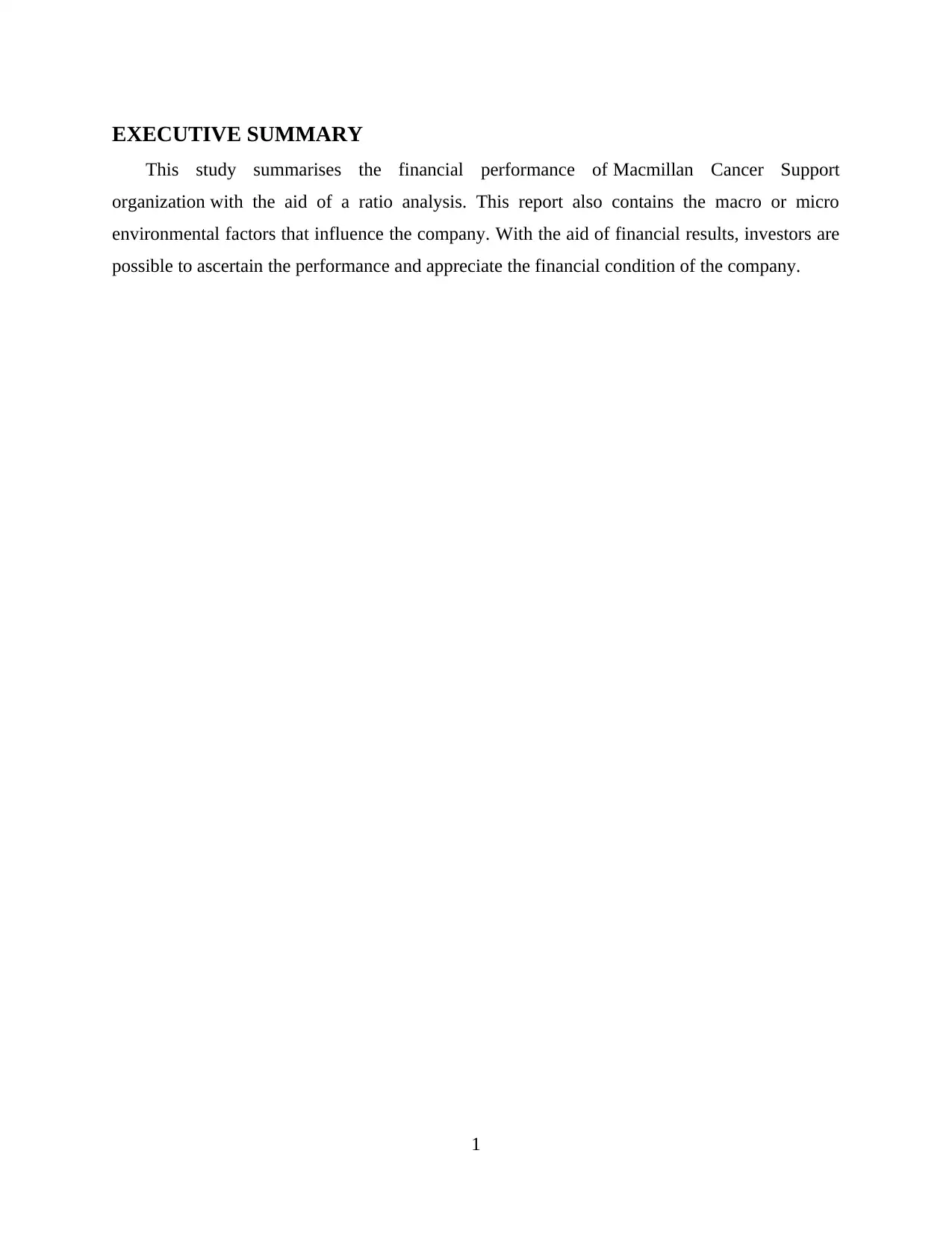
EXECUTIVE SUMMARY
This study summarises the financial performance of Macmillan Cancer Support
organization with the aid of a ratio analysis. This report also contains the macro or micro
environmental factors that influence the company. With the aid of financial results, investors are
possible to ascertain the performance and appreciate the financial condition of the company.
1
This study summarises the financial performance of Macmillan Cancer Support
organization with the aid of a ratio analysis. This report also contains the macro or micro
environmental factors that influence the company. With the aid of financial results, investors are
possible to ascertain the performance and appreciate the financial condition of the company.
1
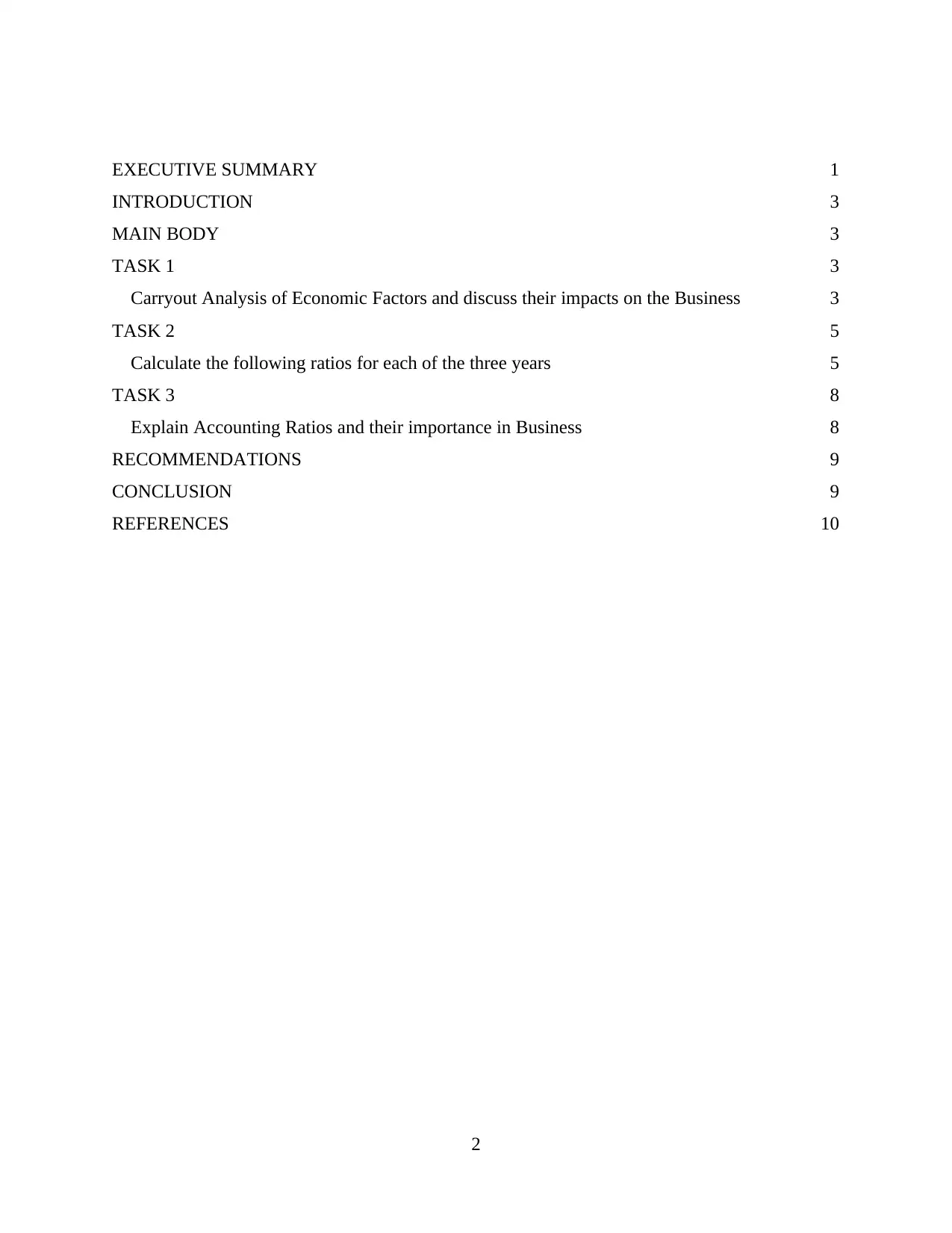
EXECUTIVE SUMMARY 1
INTRODUCTION 3
MAIN BODY 3
TASK 1 3
Carryout Analysis of Economic Factors and discuss their impacts on the Business 3
TASK 2 5
Calculate the following ratios for each of the three years 5
TASK 3 8
Explain Accounting Ratios and their importance in Business 8
RECOMMENDATIONS 9
CONCLUSION 9
REFERENCES 10
2
INTRODUCTION 3
MAIN BODY 3
TASK 1 3
Carryout Analysis of Economic Factors and discuss their impacts on the Business 3
TASK 2 5
Calculate the following ratios for each of the three years 5
TASK 3 8
Explain Accounting Ratios and their importance in Business 8
RECOMMENDATIONS 9
CONCLUSION 9
REFERENCES 10
2
⊘ This is a preview!⊘
Do you want full access?
Subscribe today to unlock all pages.

Trusted by 1+ million students worldwide
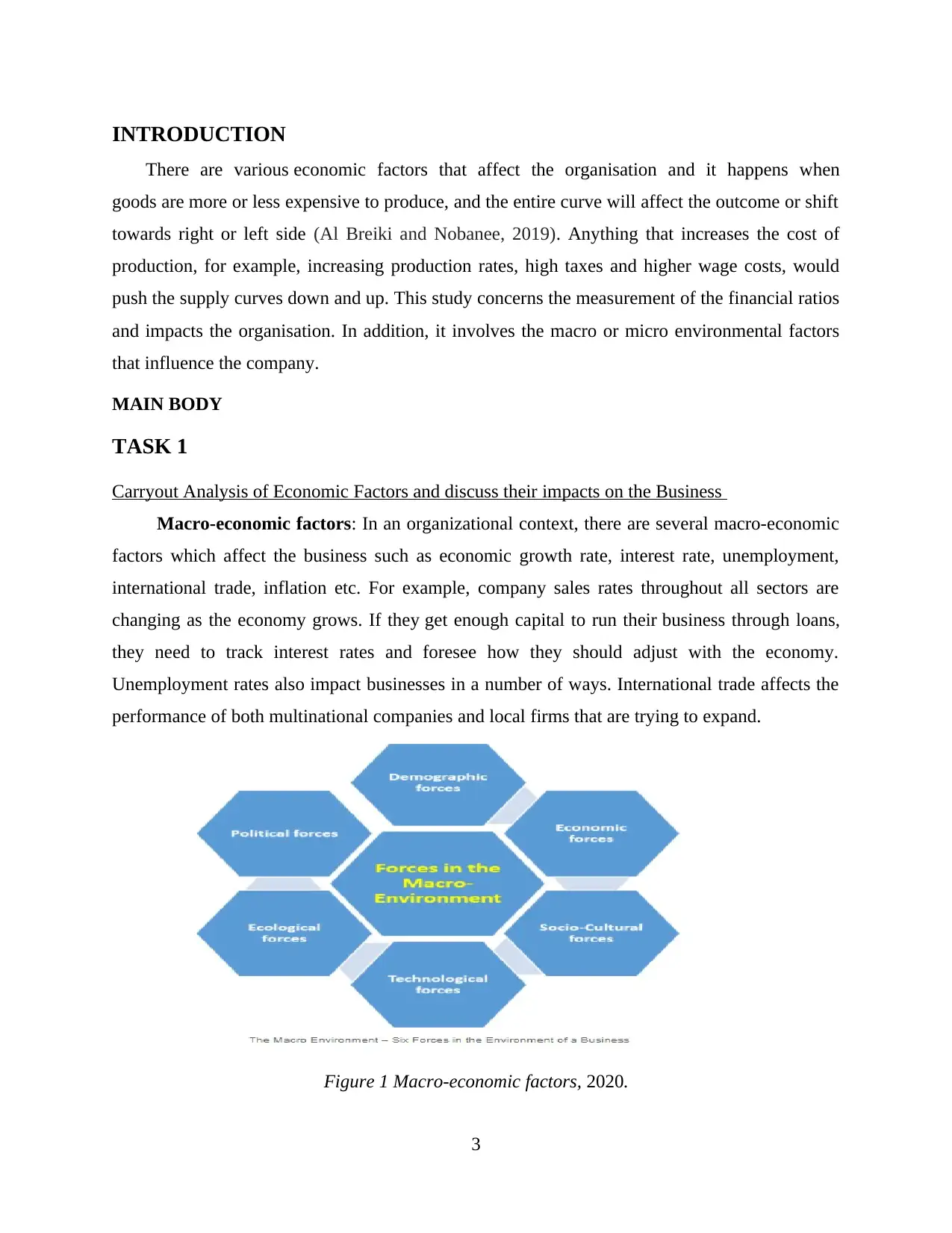
INTRODUCTION
There are various economic factors that affect the organisation and it happens when
goods are more or less expensive to produce, and the entire curve will affect the outcome or shift
towards right or left side (Al Breiki and Nobanee, 2019). Anything that increases the cost of
production, for example, increasing production rates, high taxes and higher wage costs, would
push the supply curves down and up. This study concerns the measurement of the financial ratios
and impacts the organisation. In addition, it involves the macro or micro environmental factors
that influence the company.
MAIN BODY
TASK 1
Carryout Analysis of Economic Factors and discuss their impacts on the Business
Macro-economic factors: In an organizational context, there are several macro-economic
factors which affect the business such as economic growth rate, interest rate, unemployment,
international trade, inflation etc. For example, company sales rates throughout all sectors are
changing as the economy grows. If they get enough capital to run their business through loans,
they need to track interest rates and foresee how they should adjust with the economy.
Unemployment rates also impact businesses in a number of ways. International trade affects the
performance of both multinational companies and local firms that are trying to expand.
Figure 1 Macro-economic factors, 2020.
3
There are various economic factors that affect the organisation and it happens when
goods are more or less expensive to produce, and the entire curve will affect the outcome or shift
towards right or left side (Al Breiki and Nobanee, 2019). Anything that increases the cost of
production, for example, increasing production rates, high taxes and higher wage costs, would
push the supply curves down and up. This study concerns the measurement of the financial ratios
and impacts the organisation. In addition, it involves the macro or micro environmental factors
that influence the company.
MAIN BODY
TASK 1
Carryout Analysis of Economic Factors and discuss their impacts on the Business
Macro-economic factors: In an organizational context, there are several macro-economic
factors which affect the business such as economic growth rate, interest rate, unemployment,
international trade, inflation etc. For example, company sales rates throughout all sectors are
changing as the economy grows. If they get enough capital to run their business through loans,
they need to track interest rates and foresee how they should adjust with the economy.
Unemployment rates also impact businesses in a number of ways. International trade affects the
performance of both multinational companies and local firms that are trying to expand.
Figure 1 Macro-economic factors, 2020.
3
Paraphrase This Document
Need a fresh take? Get an instant paraphrase of this document with our AI Paraphraser
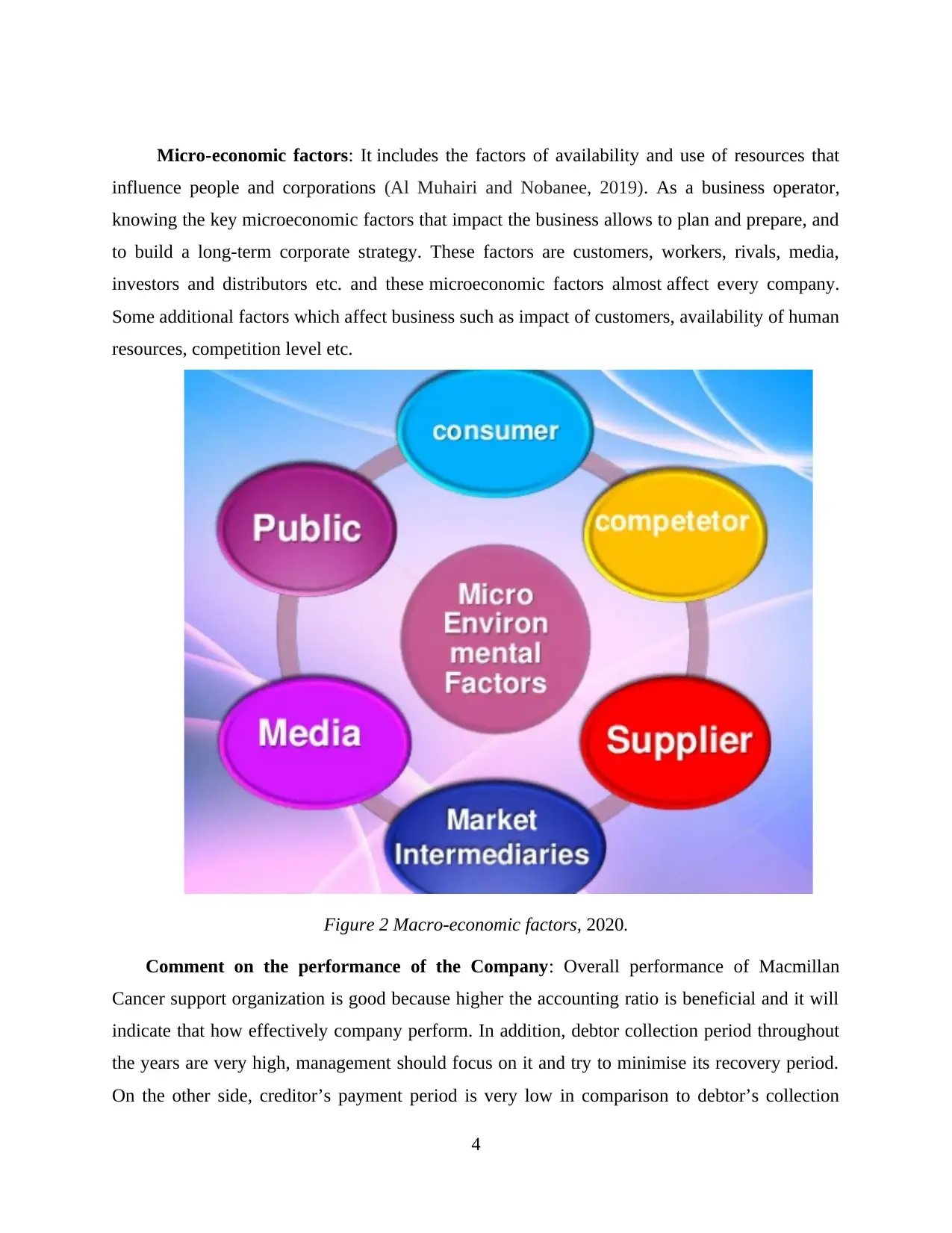
Micro-economic factors: It includes the factors of availability and use of resources that
influence people and corporations (Al Muhairi and Nobanee, 2019). As a business operator,
knowing the key microeconomic factors that impact the business allows to plan and prepare, and
to build a long-term corporate strategy. These factors are customers, workers, rivals, media,
investors and distributors etc. and these microeconomic factors almost affect every company.
Some additional factors which affect business such as impact of customers, availability of human
resources, competition level etc.
Figure 2 Macro-economic factors, 2020.
Comment on the performance of the Company: Overall performance of Macmillan
Cancer support organization is good because higher the accounting ratio is beneficial and it will
indicate that how effectively company perform. In addition, debtor collection period throughout
the years are very high, management should focus on it and try to minimise its recovery period.
On the other side, creditor’s payment period is very low in comparison to debtor’s collection
4
influence people and corporations (Al Muhairi and Nobanee, 2019). As a business operator,
knowing the key microeconomic factors that impact the business allows to plan and prepare, and
to build a long-term corporate strategy. These factors are customers, workers, rivals, media,
investors and distributors etc. and these microeconomic factors almost affect every company.
Some additional factors which affect business such as impact of customers, availability of human
resources, competition level etc.
Figure 2 Macro-economic factors, 2020.
Comment on the performance of the Company: Overall performance of Macmillan
Cancer support organization is good because higher the accounting ratio is beneficial and it will
indicate that how effectively company perform. In addition, debtor collection period throughout
the years are very high, management should focus on it and try to minimise its recovery period.
On the other side, creditor’s payment period is very low in comparison to debtor’s collection
4
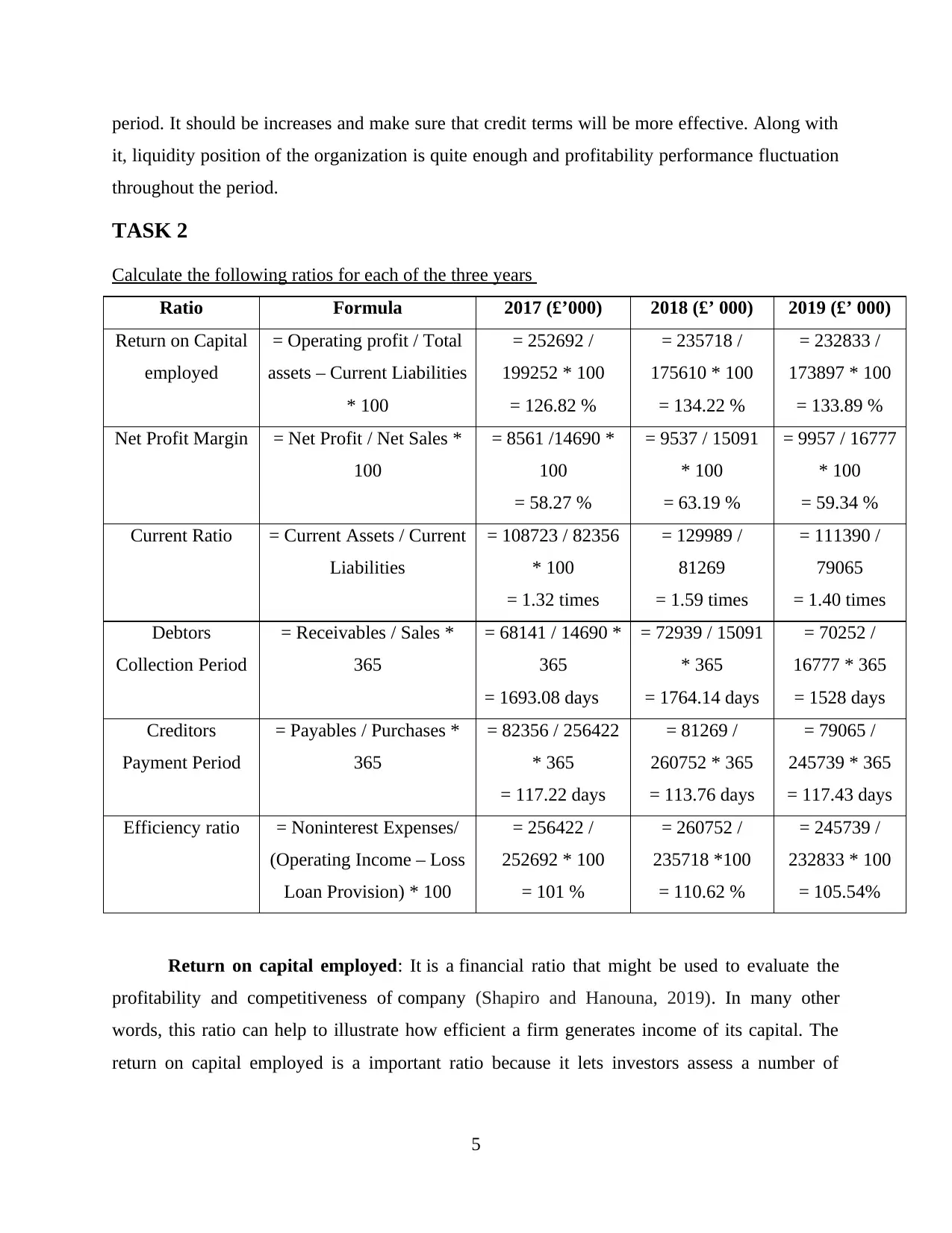
period. It should be increases and make sure that credit terms will be more effective. Along with
it, liquidity position of the organization is quite enough and profitability performance fluctuation
throughout the period.
TASK 2
Calculate the following ratios for each of the three years
Ratio Formula 2017 (£’000) 2018 (£’ 000) 2019 (£’ 000)
Return on Capital
employed
= Operating profit / Total
assets – Current Liabilities
* 100
= 252692 /
199252 * 100
= 126.82 %
= 235718 /
175610 * 100
= 134.22 %
= 232833 /
173897 * 100
= 133.89 %
Net Profit Margin = Net Profit / Net Sales *
100
= 8561 /14690 *
100
= 58.27 %
= 9537 / 15091
* 100
= 63.19 %
= 9957 / 16777
* 100
= 59.34 %
Current Ratio = Current Assets / Current
Liabilities
= 108723 / 82356
* 100
= 1.32 times
= 129989 /
81269
= 1.59 times
= 111390 /
79065
= 1.40 times
Debtors
Collection Period
= Receivables / Sales *
365
= 68141 / 14690 *
365
= 1693.08 days
= 72939 / 15091
* 365
= 1764.14 days
= 70252 /
16777 * 365
= 1528 days
Creditors
Payment Period
= Payables / Purchases *
365
= 82356 / 256422
* 365
= 117.22 days
= 81269 /
260752 * 365
= 113.76 days
= 79065 /
245739 * 365
= 117.43 days
Efficiency ratio = Noninterest Expenses/
(Operating Income – Loss
Loan Provision) * 100
= 256422 /
252692 * 100
= 101 %
= 260752 /
235718 *100
= 110.62 %
= 245739 /
232833 * 100
= 105.54%
Return on capital employed: It is a financial ratio that might be used to evaluate the
profitability and competitiveness of company (Shapiro and Hanouna, 2019). In many other
words, this ratio can help to illustrate how efficient a firm generates income of its capital. The
return on capital employed is a important ratio because it lets investors assess a number of
5
it, liquidity position of the organization is quite enough and profitability performance fluctuation
throughout the period.
TASK 2
Calculate the following ratios for each of the three years
Ratio Formula 2017 (£’000) 2018 (£’ 000) 2019 (£’ 000)
Return on Capital
employed
= Operating profit / Total
assets – Current Liabilities
* 100
= 252692 /
199252 * 100
= 126.82 %
= 235718 /
175610 * 100
= 134.22 %
= 232833 /
173897 * 100
= 133.89 %
Net Profit Margin = Net Profit / Net Sales *
100
= 8561 /14690 *
100
= 58.27 %
= 9537 / 15091
* 100
= 63.19 %
= 9957 / 16777
* 100
= 59.34 %
Current Ratio = Current Assets / Current
Liabilities
= 108723 / 82356
* 100
= 1.32 times
= 129989 /
81269
= 1.59 times
= 111390 /
79065
= 1.40 times
Debtors
Collection Period
= Receivables / Sales *
365
= 68141 / 14690 *
365
= 1693.08 days
= 72939 / 15091
* 365
= 1764.14 days
= 70252 /
16777 * 365
= 1528 days
Creditors
Payment Period
= Payables / Purchases *
365
= 82356 / 256422
* 365
= 117.22 days
= 81269 /
260752 * 365
= 113.76 days
= 79065 /
245739 * 365
= 117.43 days
Efficiency ratio = Noninterest Expenses/
(Operating Income – Loss
Loan Provision) * 100
= 256422 /
252692 * 100
= 101 %
= 260752 /
235718 *100
= 110.62 %
= 245739 /
232833 * 100
= 105.54%
Return on capital employed: It is a financial ratio that might be used to evaluate the
profitability and competitiveness of company (Shapiro and Hanouna, 2019). In many other
words, this ratio can help to illustrate how efficient a firm generates income of its capital. The
return on capital employed is a important ratio because it lets investors assess a number of
5
⊘ This is a preview!⊘
Do you want full access?
Subscribe today to unlock all pages.

Trusted by 1+ million students worldwide
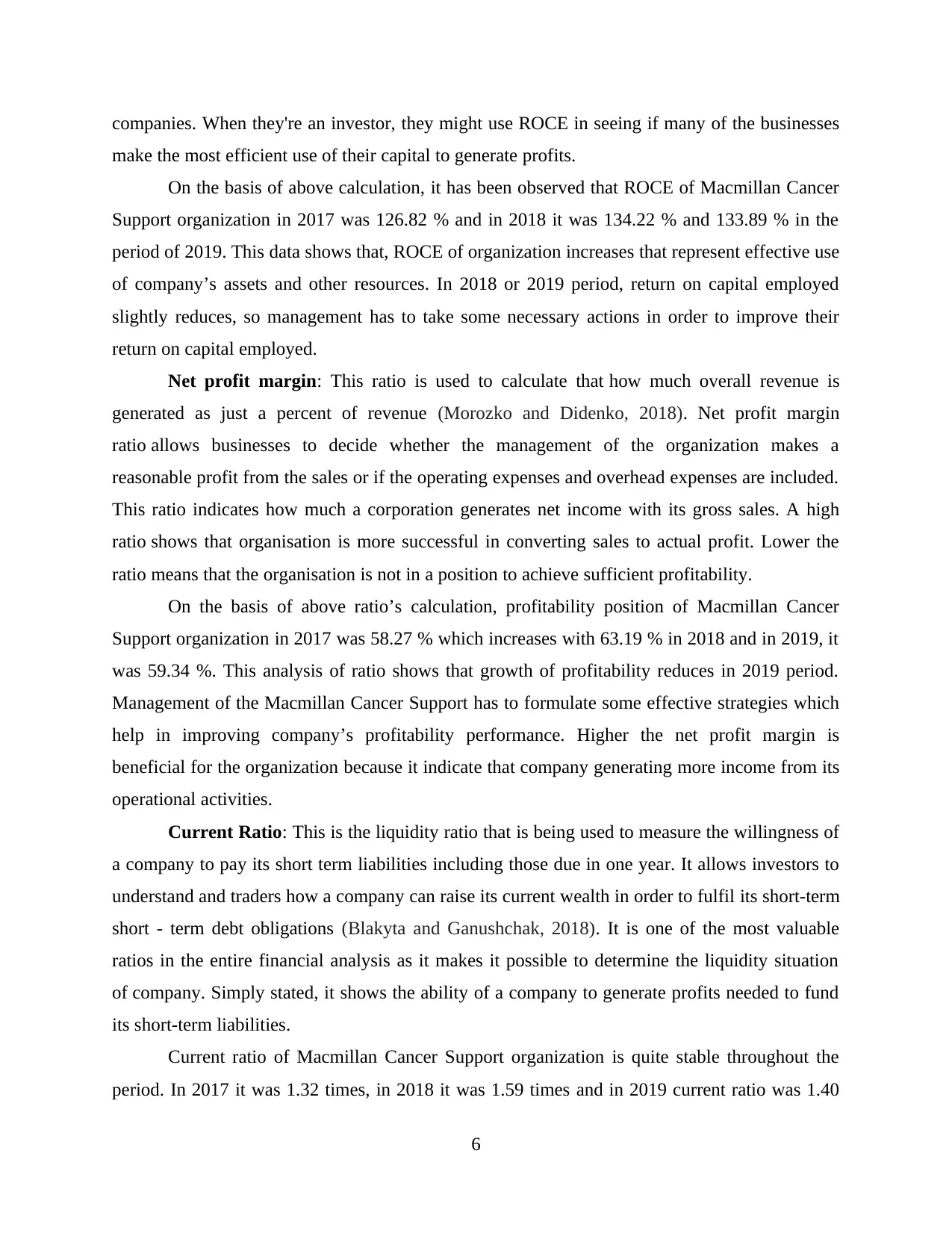
companies. When they're an investor, they might use ROCE in seeing if many of the businesses
make the most efficient use of their capital to generate profits.
On the basis of above calculation, it has been observed that ROCE of Macmillan Cancer
Support organization in 2017 was 126.82 % and in 2018 it was 134.22 % and 133.89 % in the
period of 2019. This data shows that, ROCE of organization increases that represent effective use
of company’s assets and other resources. In 2018 or 2019 period, return on capital employed
slightly reduces, so management has to take some necessary actions in order to improve their
return on capital employed.
Net profit margin: This ratio is used to calculate that how much overall revenue is
generated as just a percent of revenue (Morozko and Didenko, 2018). Net profit margin
ratio allows businesses to decide whether the management of the organization makes a
reasonable profit from the sales or if the operating expenses and overhead expenses are included.
This ratio indicates how much a corporation generates net income with its gross sales. A high
ratio shows that organisation is more successful in converting sales to actual profit. Lower the
ratio means that the organisation is not in a position to achieve sufficient profitability.
On the basis of above ratio’s calculation, profitability position of Macmillan Cancer
Support organization in 2017 was 58.27 % which increases with 63.19 % in 2018 and in 2019, it
was 59.34 %. This analysis of ratio shows that growth of profitability reduces in 2019 period.
Management of the Macmillan Cancer Support has to formulate some effective strategies which
help in improving company’s profitability performance. Higher the net profit margin is
beneficial for the organization because it indicate that company generating more income from its
operational activities.
Current Ratio: This is the liquidity ratio that is being used to measure the willingness of
a company to pay its short term liabilities including those due in one year. It allows investors to
understand and traders how a company can raise its current wealth in order to fulfil its short-term
short - term debt obligations (Blakyta and Ganushchak, 2018). It is one of the most valuable
ratios in the entire financial analysis as it makes it possible to determine the liquidity situation
of company. Simply stated, it shows the ability of a company to generate profits needed to fund
its short-term liabilities.
Current ratio of Macmillan Cancer Support organization is quite stable throughout the
period. In 2017 it was 1.32 times, in 2018 it was 1.59 times and in 2019 current ratio was 1.40
6
make the most efficient use of their capital to generate profits.
On the basis of above calculation, it has been observed that ROCE of Macmillan Cancer
Support organization in 2017 was 126.82 % and in 2018 it was 134.22 % and 133.89 % in the
period of 2019. This data shows that, ROCE of organization increases that represent effective use
of company’s assets and other resources. In 2018 or 2019 period, return on capital employed
slightly reduces, so management has to take some necessary actions in order to improve their
return on capital employed.
Net profit margin: This ratio is used to calculate that how much overall revenue is
generated as just a percent of revenue (Morozko and Didenko, 2018). Net profit margin
ratio allows businesses to decide whether the management of the organization makes a
reasonable profit from the sales or if the operating expenses and overhead expenses are included.
This ratio indicates how much a corporation generates net income with its gross sales. A high
ratio shows that organisation is more successful in converting sales to actual profit. Lower the
ratio means that the organisation is not in a position to achieve sufficient profitability.
On the basis of above ratio’s calculation, profitability position of Macmillan Cancer
Support organization in 2017 was 58.27 % which increases with 63.19 % in 2018 and in 2019, it
was 59.34 %. This analysis of ratio shows that growth of profitability reduces in 2019 period.
Management of the Macmillan Cancer Support has to formulate some effective strategies which
help in improving company’s profitability performance. Higher the net profit margin is
beneficial for the organization because it indicate that company generating more income from its
operational activities.
Current Ratio: This is the liquidity ratio that is being used to measure the willingness of
a company to pay its short term liabilities including those due in one year. It allows investors to
understand and traders how a company can raise its current wealth in order to fulfil its short-term
short - term debt obligations (Blakyta and Ganushchak, 2018). It is one of the most valuable
ratios in the entire financial analysis as it makes it possible to determine the liquidity situation
of company. Simply stated, it shows the ability of a company to generate profits needed to fund
its short-term liabilities.
Current ratio of Macmillan Cancer Support organization is quite stable throughout the
period. In 2017 it was 1.32 times, in 2018 it was 1.59 times and in 2019 current ratio was 1.40
6
Paraphrase This Document
Need a fresh take? Get an instant paraphrase of this document with our AI Paraphraser
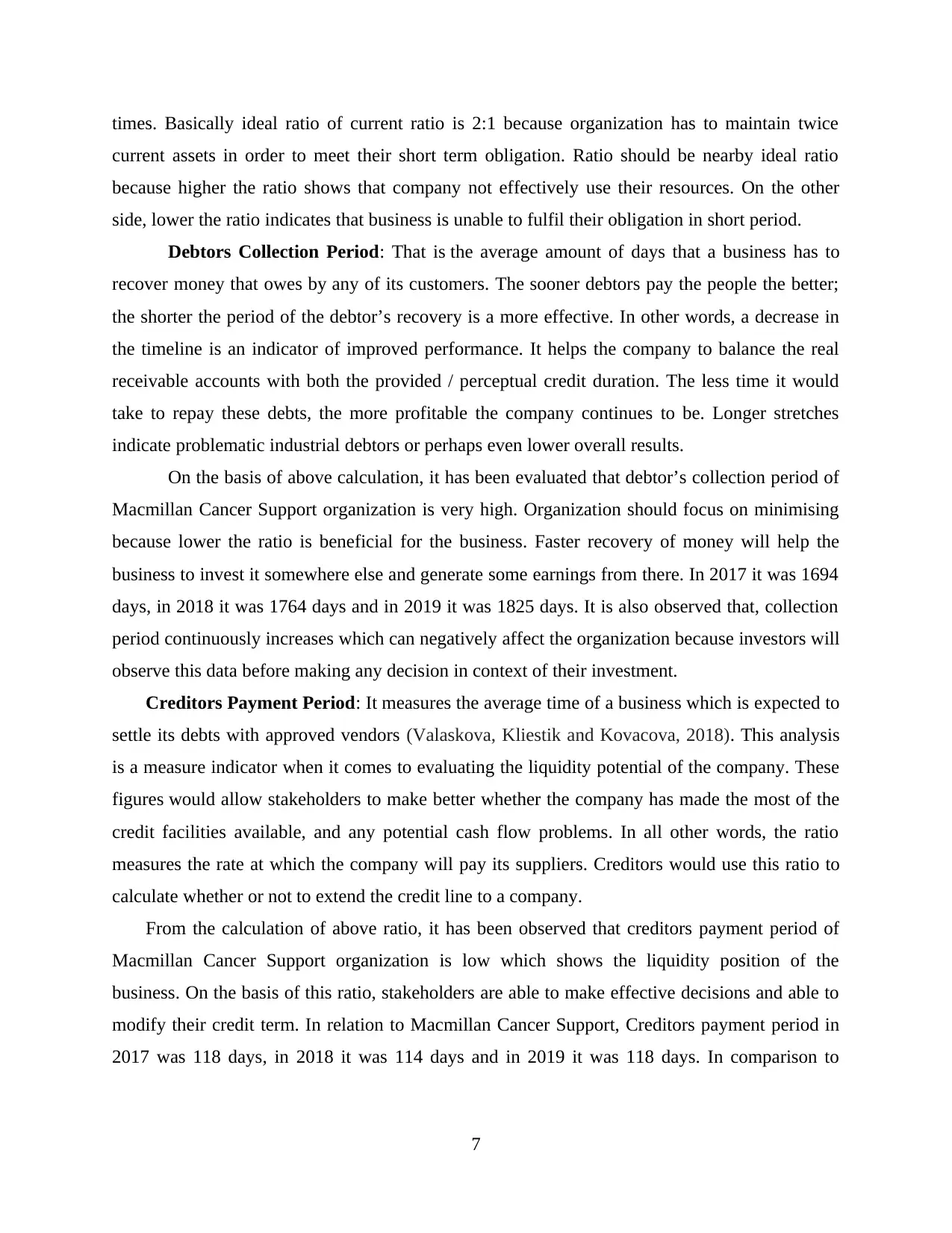
times. Basically ideal ratio of current ratio is 2:1 because organization has to maintain twice
current assets in order to meet their short term obligation. Ratio should be nearby ideal ratio
because higher the ratio shows that company not effectively use their resources. On the other
side, lower the ratio indicates that business is unable to fulfil their obligation in short period.
Debtors Collection Period: That is the average amount of days that a business has to
recover money that owes by any of its customers. The sooner debtors pay the people the better;
the shorter the period of the debtor’s recovery is a more effective. In other words, a decrease in
the timeline is an indicator of improved performance. It helps the company to balance the real
receivable accounts with both the provided / perceptual credit duration. The less time it would
take to repay these debts, the more profitable the company continues to be. Longer stretches
indicate problematic industrial debtors or perhaps even lower overall results.
On the basis of above calculation, it has been evaluated that debtor’s collection period of
Macmillan Cancer Support organization is very high. Organization should focus on minimising
because lower the ratio is beneficial for the business. Faster recovery of money will help the
business to invest it somewhere else and generate some earnings from there. In 2017 it was 1694
days, in 2018 it was 1764 days and in 2019 it was 1825 days. It is also observed that, collection
period continuously increases which can negatively affect the organization because investors will
observe this data before making any decision in context of their investment.
Creditors Payment Period: It measures the average time of a business which is expected to
settle its debts with approved vendors (Valaskova, Kliestik and Kovacova, 2018). This analysis
is a measure indicator when it comes to evaluating the liquidity potential of the company. These
figures would allow stakeholders to make better whether the company has made the most of the
credit facilities available, and any potential cash flow problems. In all other words, the ratio
measures the rate at which the company will pay its suppliers. Creditors would use this ratio to
calculate whether or not to extend the credit line to a company.
From the calculation of above ratio, it has been observed that creditors payment period of
Macmillan Cancer Support organization is low which shows the liquidity position of the
business. On the basis of this ratio, stakeholders are able to make effective decisions and able to
modify their credit term. In relation to Macmillan Cancer Support, Creditors payment period in
2017 was 118 days, in 2018 it was 114 days and in 2019 it was 118 days. In comparison to
7
current assets in order to meet their short term obligation. Ratio should be nearby ideal ratio
because higher the ratio shows that company not effectively use their resources. On the other
side, lower the ratio indicates that business is unable to fulfil their obligation in short period.
Debtors Collection Period: That is the average amount of days that a business has to
recover money that owes by any of its customers. The sooner debtors pay the people the better;
the shorter the period of the debtor’s recovery is a more effective. In other words, a decrease in
the timeline is an indicator of improved performance. It helps the company to balance the real
receivable accounts with both the provided / perceptual credit duration. The less time it would
take to repay these debts, the more profitable the company continues to be. Longer stretches
indicate problematic industrial debtors or perhaps even lower overall results.
On the basis of above calculation, it has been evaluated that debtor’s collection period of
Macmillan Cancer Support organization is very high. Organization should focus on minimising
because lower the ratio is beneficial for the business. Faster recovery of money will help the
business to invest it somewhere else and generate some earnings from there. In 2017 it was 1694
days, in 2018 it was 1764 days and in 2019 it was 1825 days. It is also observed that, collection
period continuously increases which can negatively affect the organization because investors will
observe this data before making any decision in context of their investment.
Creditors Payment Period: It measures the average time of a business which is expected to
settle its debts with approved vendors (Valaskova, Kliestik and Kovacova, 2018). This analysis
is a measure indicator when it comes to evaluating the liquidity potential of the company. These
figures would allow stakeholders to make better whether the company has made the most of the
credit facilities available, and any potential cash flow problems. In all other words, the ratio
measures the rate at which the company will pay its suppliers. Creditors would use this ratio to
calculate whether or not to extend the credit line to a company.
From the calculation of above ratio, it has been observed that creditors payment period of
Macmillan Cancer Support organization is low which shows the liquidity position of the
business. On the basis of this ratio, stakeholders are able to make effective decisions and able to
modify their credit term. In relation to Macmillan Cancer Support, Creditors payment period in
2017 was 118 days, in 2018 it was 114 days and in 2019 it was 118 days. In comparison to
7

debtor’s collection period, creditor’s payments period is very low. Management of Macmillan
Cancer Support has to build some strategies and ensure that it lead to the results.
Efficiency ratio: It compares exactly what company owns including its sales or profit
performance, and informs investors about both the ability of a corporation to use what it has to
generate quite enough cash as possible for partners and customers. The efficiency ratio of 50
percent or less is considered to be optimal. If the productivity ratio does not increase, it implies
that the bank's expenses are increasing or that its revenues are decreasing (Lai and Locatelli,
2020). These calculations measure how efficiently a company uses its assets to make money and
retain those assets. This measure is used to compare the net profits of a company including its
average total assets.
On the basis of ratio’s calculation, it has been interpreted that efficiency ratio of Macmillan
Cancer Support in 2017 was 101 %, in 2018 it was 110.62 % and in 2019 it was 105.54 %. It has
been observed that, ratio increases for the period of 2017 to 2018 but in 2019 it was reduces due
to some reasons which reduces the overall performance of the organization. Management of the
organization should identify those factors which affect the overall performance and outcomes.
Higher the efficiency ratio is beneficial for the business which indicate that company perform in
maximum efficiency to generate high results.
TASK 3
Explain Accounting Ratios and their importance in Business
Accounting ratios are a primary sub-set of financial analysis and these are a group of metrics
to measure the efficiency and profitability of a company extracted from financial statements
(Madura, 2020). They may provide a forum for release of a relationship between one financial
information point and other is the foundation for a ratio analysis. These ratios could also be used
to calculate the dynamics of a sector, and to include data mostly on business's output over the last
quarter or financial year. Common financial indicators have included the current ratio,
profitability ratio, quick ratio, the pay-out ratio, the gross margin and the operating income.
Accounting ratios are being used by company itself to improve or monitor progress and by
investors to determine the best investment option.
8
Cancer Support has to build some strategies and ensure that it lead to the results.
Efficiency ratio: It compares exactly what company owns including its sales or profit
performance, and informs investors about both the ability of a corporation to use what it has to
generate quite enough cash as possible for partners and customers. The efficiency ratio of 50
percent or less is considered to be optimal. If the productivity ratio does not increase, it implies
that the bank's expenses are increasing or that its revenues are decreasing (Lai and Locatelli,
2020). These calculations measure how efficiently a company uses its assets to make money and
retain those assets. This measure is used to compare the net profits of a company including its
average total assets.
On the basis of ratio’s calculation, it has been interpreted that efficiency ratio of Macmillan
Cancer Support in 2017 was 101 %, in 2018 it was 110.62 % and in 2019 it was 105.54 %. It has
been observed that, ratio increases for the period of 2017 to 2018 but in 2019 it was reduces due
to some reasons which reduces the overall performance of the organization. Management of the
organization should identify those factors which affect the overall performance and outcomes.
Higher the efficiency ratio is beneficial for the business which indicate that company perform in
maximum efficiency to generate high results.
TASK 3
Explain Accounting Ratios and their importance in Business
Accounting ratios are a primary sub-set of financial analysis and these are a group of metrics
to measure the efficiency and profitability of a company extracted from financial statements
(Madura, 2020). They may provide a forum for release of a relationship between one financial
information point and other is the foundation for a ratio analysis. These ratios could also be used
to calculate the dynamics of a sector, and to include data mostly on business's output over the last
quarter or financial year. Common financial indicators have included the current ratio,
profitability ratio, quick ratio, the pay-out ratio, the gross margin and the operating income.
Accounting ratios are being used by company itself to improve or monitor progress and by
investors to determine the best investment option.
8
⊘ This is a preview!⊘
Do you want full access?
Subscribe today to unlock all pages.

Trusted by 1+ million students worldwide
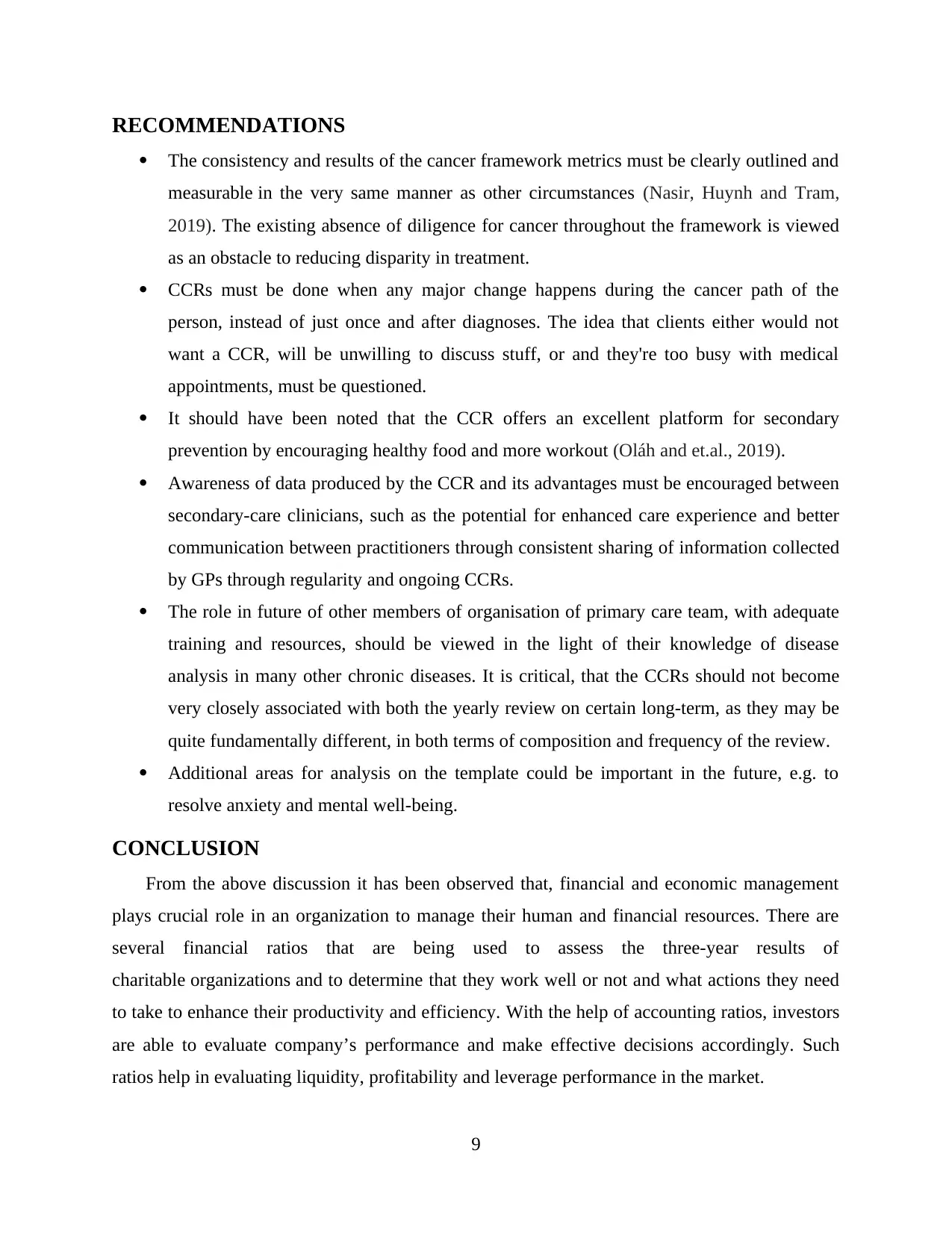
RECOMMENDATIONS
The consistency and results of the cancer framework metrics must be clearly outlined and
measurable in the very same manner as other circumstances (Nasir, Huynh and Tram,
2019). The existing absence of diligence for cancer throughout the framework is viewed
as an obstacle to reducing disparity in treatment.
CCRs must be done when any major change happens during the cancer path of the
person, instead of just once and after diagnoses. The idea that clients either would not
want a CCR, will be unwilling to discuss stuff, or and they're too busy with medical
appointments, must be questioned.
It should have been noted that the CCR offers an excellent platform for secondary
prevention by encouraging healthy food and more workout (Oláh and et.al., 2019).
Awareness of data produced by the CCR and its advantages must be encouraged between
secondary-care clinicians, such as the potential for enhanced care experience and better
communication between practitioners through consistent sharing of information collected
by GPs through regularity and ongoing CCRs.
The role in future of other members of organisation of primary care team, with adequate
training and resources, should be viewed in the light of their knowledge of disease
analysis in many other chronic diseases. It is critical, that the CCRs should not become
very closely associated with both the yearly review on certain long-term, as they may be
quite fundamentally different, in both terms of composition and frequency of the review.
Additional areas for analysis on the template could be important in the future, e.g. to
resolve anxiety and mental well-being.
CONCLUSION
From the above discussion it has been observed that, financial and economic management
plays crucial role in an organization to manage their human and financial resources. There are
several financial ratios that are being used to assess the three-year results of
charitable organizations and to determine that they work well or not and what actions they need
to take to enhance their productivity and efficiency. With the help of accounting ratios, investors
are able to evaluate company’s performance and make effective decisions accordingly. Such
ratios help in evaluating liquidity, profitability and leverage performance in the market.
9
The consistency and results of the cancer framework metrics must be clearly outlined and
measurable in the very same manner as other circumstances (Nasir, Huynh and Tram,
2019). The existing absence of diligence for cancer throughout the framework is viewed
as an obstacle to reducing disparity in treatment.
CCRs must be done when any major change happens during the cancer path of the
person, instead of just once and after diagnoses. The idea that clients either would not
want a CCR, will be unwilling to discuss stuff, or and they're too busy with medical
appointments, must be questioned.
It should have been noted that the CCR offers an excellent platform for secondary
prevention by encouraging healthy food and more workout (Oláh and et.al., 2019).
Awareness of data produced by the CCR and its advantages must be encouraged between
secondary-care clinicians, such as the potential for enhanced care experience and better
communication between practitioners through consistent sharing of information collected
by GPs through regularity and ongoing CCRs.
The role in future of other members of organisation of primary care team, with adequate
training and resources, should be viewed in the light of their knowledge of disease
analysis in many other chronic diseases. It is critical, that the CCRs should not become
very closely associated with both the yearly review on certain long-term, as they may be
quite fundamentally different, in both terms of composition and frequency of the review.
Additional areas for analysis on the template could be important in the future, e.g. to
resolve anxiety and mental well-being.
CONCLUSION
From the above discussion it has been observed that, financial and economic management
plays crucial role in an organization to manage their human and financial resources. There are
several financial ratios that are being used to assess the three-year results of
charitable organizations and to determine that they work well or not and what actions they need
to take to enhance their productivity and efficiency. With the help of accounting ratios, investors
are able to evaluate company’s performance and make effective decisions accordingly. Such
ratios help in evaluating liquidity, profitability and leverage performance in the market.
9
Paraphrase This Document
Need a fresh take? Get an instant paraphrase of this document with our AI Paraphraser

REFERENCES
Books & Journals
Al Breiki, M. and Nobanee, H., 2019. The role of financial management in promoting
sustainable business practices and development. Available at SSRN 3472404.
Al Muhairi, M. and Nobanee, H., 2019. Sustainable financial management. Available at SSRN
3472417.
Blakyta, G. and Ganushchak, T., 2018. Enterprise financial security as a component of the
economic security of the state. Investment management and financial innovations, 15(2),
pp.248-256.
Lai, C. S. and Locatelli, G., 2020. Economic and financial appraisal of novel large-scale energy
storage technologies. Energy, p.118954.
Madura, J., 2020. International financial management. Cengage Learning.
Morozko, N. and Didenko, V., 2018. Financial management of small organizations based on a
cognitive approach.
Nasir, M.A., Huynh, T.L.D. and Tram, H.T.X., 2019. Role of financial development, economic
growth & foreign direct investment in driving climate change: A case of emerging
ASEAN. Journal of environmental management, 242, pp.131-141.
Oláh, J., Kovács, S., Virglerova, Z., Lakner, Z., Kovacova, M. and Popp, J., 2019. Analysis and
comparison of economic and financial risk sources in SMEs of the visegrad group and
serbia. Sustainability, 11(7), p.1853.
Shapiro, A.C. and Hanouna, P., 2019. Multinational financial management. John Wiley & Sons.
Valaskova, K., Kliestik, T. and Kovacova, M., 2018. Management of financial risks in Slovak
enterprises using regression analysis. Oeconomia Copernicana, 9(1), pp.105-121.
Online
Annual Report 2017. [Online]. Available Through:
<macmillan.org.uk/_images/macmillan-cancer-support-annual-report-2017_tcm9-
326894.pdf>
Annual Report 2019. [Online]. Available Through:
<https://www.macmillan.org.uk/_images/2019-annual-report-and-accounts_tcm9-
358602.pdf>
10
Books & Journals
Al Breiki, M. and Nobanee, H., 2019. The role of financial management in promoting
sustainable business practices and development. Available at SSRN 3472404.
Al Muhairi, M. and Nobanee, H., 2019. Sustainable financial management. Available at SSRN
3472417.
Blakyta, G. and Ganushchak, T., 2018. Enterprise financial security as a component of the
economic security of the state. Investment management and financial innovations, 15(2),
pp.248-256.
Lai, C. S. and Locatelli, G., 2020. Economic and financial appraisal of novel large-scale energy
storage technologies. Energy, p.118954.
Madura, J., 2020. International financial management. Cengage Learning.
Morozko, N. and Didenko, V., 2018. Financial management of small organizations based on a
cognitive approach.
Nasir, M.A., Huynh, T.L.D. and Tram, H.T.X., 2019. Role of financial development, economic
growth & foreign direct investment in driving climate change: A case of emerging
ASEAN. Journal of environmental management, 242, pp.131-141.
Oláh, J., Kovács, S., Virglerova, Z., Lakner, Z., Kovacova, M. and Popp, J., 2019. Analysis and
comparison of economic and financial risk sources in SMEs of the visegrad group and
serbia. Sustainability, 11(7), p.1853.
Shapiro, A.C. and Hanouna, P., 2019. Multinational financial management. John Wiley & Sons.
Valaskova, K., Kliestik, T. and Kovacova, M., 2018. Management of financial risks in Slovak
enterprises using regression analysis. Oeconomia Copernicana, 9(1), pp.105-121.
Online
Annual Report 2017. [Online]. Available Through:
<macmillan.org.uk/_images/macmillan-cancer-support-annual-report-2017_tcm9-
326894.pdf>
Annual Report 2019. [Online]. Available Through:
<https://www.macmillan.org.uk/_images/2019-annual-report-and-accounts_tcm9-
358602.pdf>
10
1 out of 11
Related Documents
Your All-in-One AI-Powered Toolkit for Academic Success.
+13062052269
info@desklib.com
Available 24*7 on WhatsApp / Email
![[object Object]](/_next/static/media/star-bottom.7253800d.svg)
Unlock your academic potential
Copyright © 2020–2025 A2Z Services. All Rights Reserved. Developed and managed by ZUCOL.





